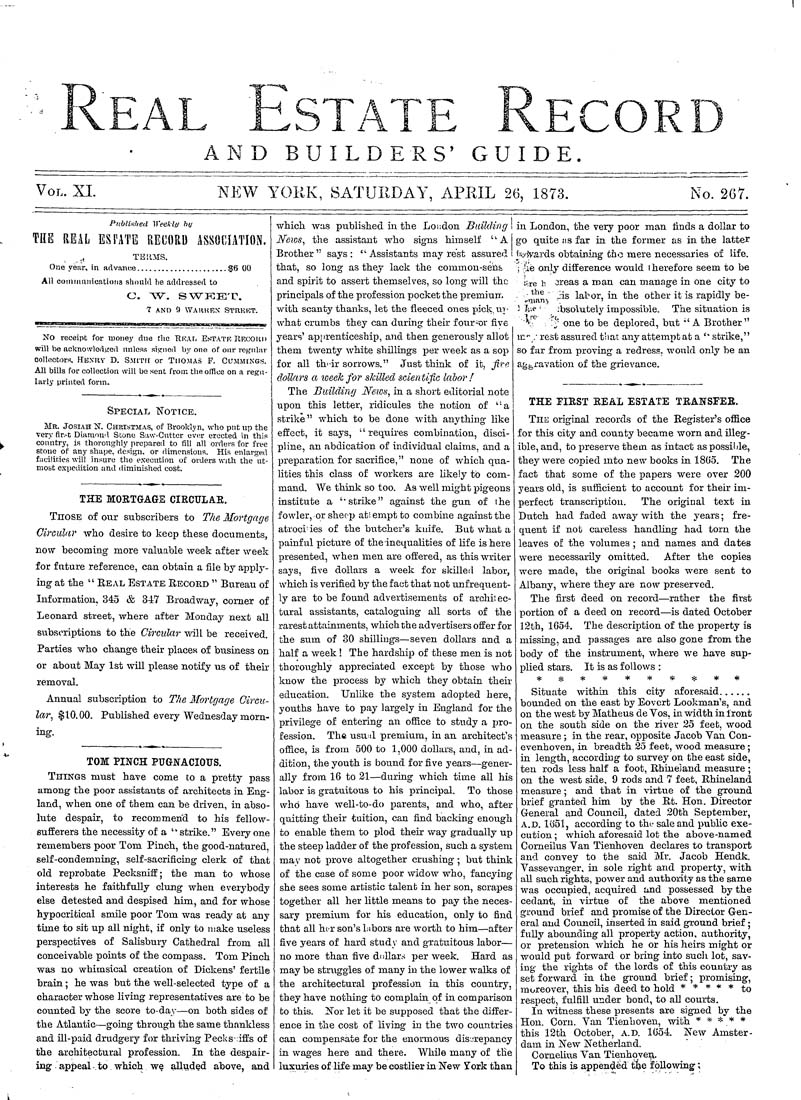Columbia University Libraries Digital Collections: The Real Estate Record
Use your browser's Print function to print these pages.
Real estate record and builders' guide: v. 11, no. 267: April 26, 1873

Text version:
Please note: this text may be incomplete. For more information about this OCR, view About OCR text.
-■^r"""^ AND B U ï L RS' GUIDE. Vol. XI. NEW YOKK, SATUEDAY, APKIL 26, 1873. No. 267, Published IVeekla bu THE REAL ESTATE REllORD ASSOCIATION. ,, TEllMS. One yèar, in adv.auce......................$6 00 Ail communications should he addressed to O. AV. SWKE'r. 7 ANO 9 Warukx Strkut. No receipfc for rooney due the Ri'Ur, Est.ate Record will be acknowledged nnless signed by one of our regnlar coUecfcors, Hb.vtiy D, S.aiitii or TiiO.UAS F. Cir.Ai.AiiNGS. AU billa for collection will besent from theolUce on a regu¬ larly printed form. SPECIAL Notice. Mr. Josiah N, Chp.istma.s, of Brooklyn, who pnt up the very fir.~t Diaraoud Stone Saw-Cuttcr ever erected in this conntry, is thoroughly prcpareil to fill ail orders for free stone of any shape, design, or dimensions. His enlarged facilities w-ill insure fche e.xecution of orders with the ut¬ most expédition and diminished cosfc. THE MORTGAGE CIRCULAS. TnosE of our subscribers to The Mortgage Circular who désire to keep thèse documents, now becoming more valuable Aveek after AA'-eek for future référence, can obtain a file by apply¬ ing at the " Real Estate Record " Bureau of Information, 345 & 347 Broadway, corner of Léonard street, where after Monday next ail subsoriptions to the Circular vnll be recei\'ed. Parties who change their places of business on or about May lst Avill please notify us of their removal. Annual subscription to The Mortgage Circu¬ lar, ,$10.00. Published every Wednesday morn¬ ing. TOM PINCH PUGNACIOUS. Things must have come to a pretty pass among the poor assistants of architects in Eng¬ land, when one of them can be driven, in abso¬ lute despair, to recommehd to his felloAv- sufEerers the necessity of a " strike. " Every one remembers poor Tom Pinch, the good-natured. self-condemning, self-sacrificing clerk of that old reprobate Pecksniff; the man to Avhose interests he faithfully clung Avhen everybody else detested and despised him, and for whose hypocritical smile poor Tom was ready at any time to sit up ail night, if only to make useless perspectives of Sahsbury Cathedral from ail conceivable points of the compass. Tom Pinch was no whimsical création of Dickens' fertile brain ; he was but the well-selected tj'^pe of a character whose living représentatives are to be counted by the score to-day—on both sides of the Atlantic—going through the same thankless and ill-paid drudgery for thriving Pecks-iffs of the architectural profession. In the despair- ing. appeal-to which we aUuded above, and which was published in the London Building i Neios, the assistant who signs himself " AI Brother" says: " Assistants may rest assured i that, so long as they lack the common-seûs and spirit to assert themselves, so long Avill the principals of the profession pocket the premiun. Avith scanty thanks, let the fleeced ones pick.u]- AA'hat crumbs they can during their four-or five years' apjirenticeship, and then generously allot them twenty white shillings per Aveek as a sop for ail th'-ir sorrows." Just think of it, five dollars a loeekfor slcilled scientific lahor ! The Building Neios, in a short editorial note upon this letter, ridicules the notion of "a strike" which to be done Avith anything like eiïect, it says, "requires combination, disci¬ pline, an abdication of individual claims, and a préparation for sacrifice," none of Avhich qua¬ lities this class of Avorkers are likely tô com¬ mand, We think so too. As Avell might pigeons institute a '"strike" against the g-un of the fowler, or sheci.) atiemptto combine against the atroci'ies of the butcher's kuife. But what a painful picture of theinequalities of life ishere presented, AA^hen men are ofliered, as this writer says, five dollars a Aveek for skilled labor, which is verified by the fact that not unfrequent¬ ly are to be found advertisements of archiî ec- tural assistants, cataloguing ail sorts of the rarest attainments, which the advertisers offer for the sum of 30 shillings—seven dollars and a half a Aveek ! The hardship of thèse men is not thoroughly appreciated except by those Avho know the process by Avhich they obtain their éducation, Unlike the system adopted hère, youths have to pay largely in England for the privilège of entering an office to study a pro¬ fession. The usuid premium, in an architect's office, is from 500 to 1,000 dollars, and, in ad¬ dition, the youth is bound for five years—gener¬ ally from 16 to 21—during Avhich time ail his labor is gratuitous to his principal, To those who have well-to-do parents, and who, after quitting their tuition, can find backing enough to enable them to plod their Avay gradually up the steep ladder of the profession, such a system may not prove altogether crushing ; but think of the case of some poor Avidow who, fancying she sees some artistic talent in her son, scrapes together ail her little means to pay the neces¬ sary premium for his éducation, only to find that ail hc-r son's labors are Avorth to him—after five years of hard study and gratuitous labor— no more than five dnUars per week. Hard as may be struggles of many iu the lower walks of the architectural profession ia this country, they have nothing to complam of in comparison to this. Xor let it be supposed that the différ¬ ence in the cost of living in the two countries can compensate for the enormous disia-epancy in wages hère and there. While many of tlie luxuries of lif e may be costlier in New îork than in London, the very poor man finds a dollar to go quite iis far in the former as in the latter